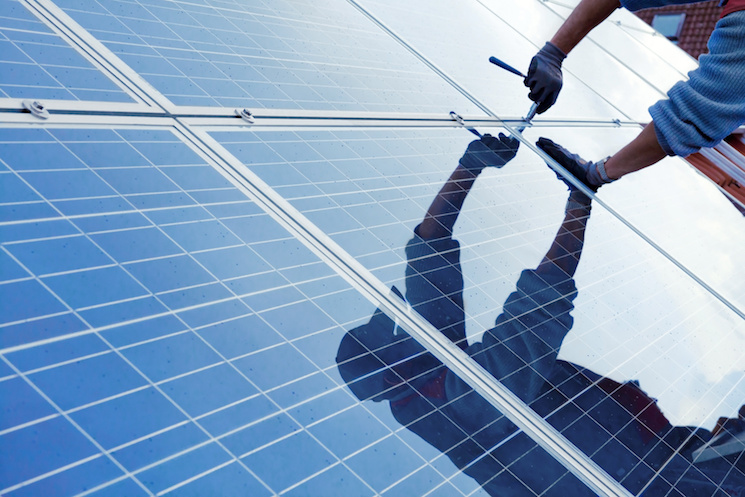January 23, 2015


A proposed textile-based hybrid solar product combines photovoltaic (PV) and solar thermal components into a single system that provides both electricity and heat. This configuration can quadruple the energy output of a conventional PV array.
Developed by Textile Testing & Innovation LLC, of Longmont, Colorado, this hybrid system uses a spacer fabric treated with phase change material (PCM) that absorbs excess heat from the PV modules. This keeps the modules within their optimal temperature range, which enhances their output.
The thermal energy stored in the PCM is then used for heating water. Cold water pumped through thin capillaries integrated into the spacer fabric absorbs the heat stored in the PCM. The warm water can be used immediately or stored.
The textile-based collector is lightweight, thin, and flexible. The collector fits any roof shape and can be used on residential and commercial buildings. The collector can also be used for swimming pool or greenhouse covers as well as emergency shelters in disaster areas.
The system addresses the growing problem of having a solar array on a roof crowd out other solar technologies. It also reduces PV module overheating, which causes steep decreases in electrical output.
Currently available PV/thermal collectors combine PV panels with solar thermal collectors. The result is a product that is bulky, heavy, and more expensive than using both a conventional PV panel and a thermal collector to achieve the same performance. The new system uses PCM to produce a lighter, less expensive, more efficient system.
Phase change material
A PCM changes its physical state from a solid to a liquid within a certain temperature range. During this melting process, the PCM absorbs and stores a large amount of latent heat. The temperature of the PCM remains nearly constant during the entire process. When the phase change is complete, a continuous heating process leads to a temperature increase and the absorption of a much smaller amount of sensible heat.
During the cooling process, the latent heat stored in the PCM is released into the surrounding area, and the phase change reverses from the liquid to the solid state. During this crystallization process, the temperature of the PCM also remains constant. The high heat transfer during the melting process and the crystallization process makes the PCM an excellent means for storing heat.
A convenient example of this process is the phase change of ice to water. When ice melts, it absorbs an amount of latent heat of about 335 kilojoules per kilogram (kJ/kg). When the water is further heated, it absorbs a sensible heat of only 4 kJ/kg while its temperature rises by one degree Celsius (1°C). Thus, water needs to be heated from about 1°C to about 84°C in order to absorb the same amount of heat that is absorbed during the melting process of ice.
In addition to ice (water), there are more than 500 natural and synthetic PCMs, such as paraffin, salt hydrates, organics, or eutectics. These materials differ from one another in their phase change temperature ranges and their latent heat storage capacities. In this application, we use a non-combustible salt hydrate PCM with a latent heat storage capacity of about 300 kJ/kg and a trigger temperature of about 45°C.
System Description
The textile-based hybrid PV/thermal collector consists of a spacer fabric with integrated capillaries. A protective coating applied to the back side of the spacer fabric protects it from the elements. The front side faces thin-film PV cells and is coated with a silicone compound containing the PCM as a thermal storage medium. During the coating procedure, the silicone compound penetrates into the spacer fabric and encloses the capillaries completely. The thin-film PV cells are then laminated onto the surface of the PCM coating layer.
The thin-film PV cells of the textile-based hybrid PV/thermal collector convert solar radiation into electricity. As soon as the temperature of the PV cell reaches the trigger temperature, the excess heat is absorbed by the PCM integrated into the silicone coating compound. In this way, the PV cell is cooled and can operate optimally.
Tests have also shown that the PCM-cooling used in the textile-based hybrid PV/thermal system is more efficient than the forced liquid or air cooling used in commercial hybrid PV/thermal systems, because there is direct contact between the PV cell and the heat absorber. The absorbed heat is stored in the PCM and is only released when water is pumped through the capillaries. This process also recharges the PCM for the next cycle of heat absorption.
In addition to the automated operation of the system through the thermostat, it can also be operated manually. The warm water can be used instantly and/or stored in an intermediate hot water tank. This strategy eliminates the need for a heat exchanger and its components or a large storage tank, reduces costs, and saves space. There is no need for constant water flow through the textile-based hybrid PV/thermal system because the PV cells are cooled by the latent heat absorption of the PCM and not by the circulating water used in conventional systems.
The textile-based hybrid PV/thermal collector is roughly 75 to 80 percent lighter and about 50 percent less expensive than a comparable conventional PV/thermal system based on the same performance. Its maintenance requirements and operational costs are also lower. The higher overall efficiency means that the breakeven point for the PV/thermal hybrid will be much shorter.
For more information, contact Barbara Pause, pause@textile-testing.com.




